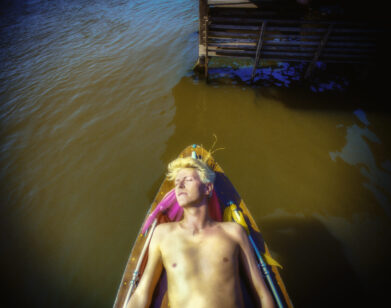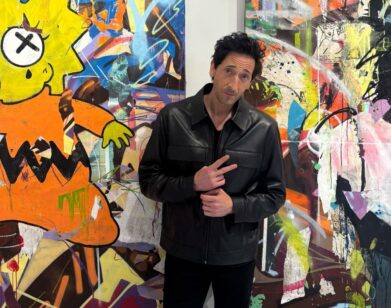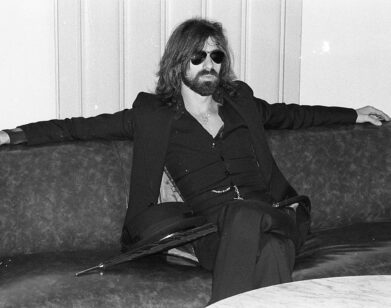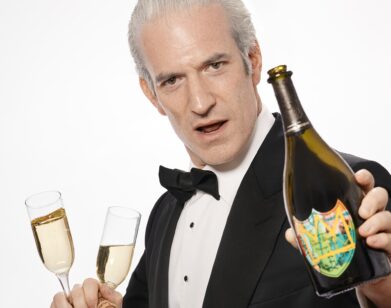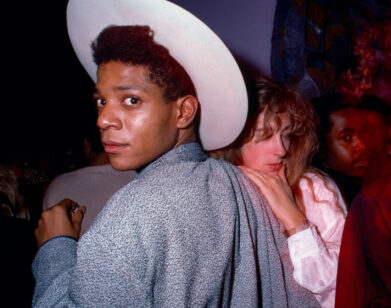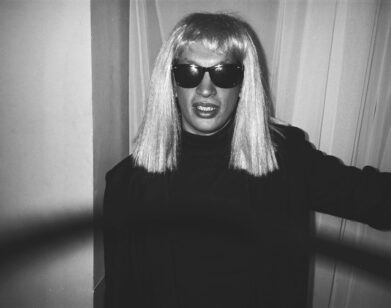Before Coronavirus, Olivia Laing Wrote A Book About the Role of Art in A Crisis

Photo by Sophie Davidson. Collage by Jack Vhay.
Holding court at the center of the British literary scene, Olivia Laing has, through her literary criticism helped elevate milennial authors such as Sally Rooney from mere writers to generational voices. But the London-based cultural critic is also prolific author, having published a new book almost every year since 2011. Her best-known work, The Lonely City, melded memoir and art criticism into a kind of creative therapy. She followed that with Crudo, a semi-experimental foray into living through the disintegration of liberal democracy, which is, in a way, the predecessor to Jenny Offill‘s Weather. And that’s all on top of her regular column in Frieze magazine, Funny Weather, after which her new release is named
In Funny Weather: Art in an Emergency, Laing asks if art can do anything to save us from crises. Could art, perhaps, provide fertile ground for understanding these moments of collective chaos? As Laing notes, “This is not a depressing book.” Funny Weather is not witty critique—although it is witty; rather, the author takes up Eve Sedgwick‘s call to, as Laing puts it, “be fundamentally more invested in finding nourishment than identifying poison.”
–––
SHANTI ESCALANTE: Releasing Funny Weather: Art in an Emergency during a worldwide plague seems like fate. Have you seen anything coming out of this crisis that interests you, gives you hope?
OLIVIA LAING: Of course. There’s an extraordinary amount of community care and solidarity that is moving and inspiring to witness. It’s a crisis that affects the whole world, albeit unequally, and it’s brought about drastic changes that we have long been told are impossible, from canceling NHS debt to providing universal basic income to halting global air travel. I hope that when the pandemic is over some of that energy and ingenuity can be mobilized toward climate change.
ESCALANTE: Has your life changed much with the social distancing orders?
LAING: The U.K. is under lockdown so, yes, drastically. I haven’t left my house except to take short walks around the block in nearly a month. My husband is over 70, so we can’t even go food shopping.
ESCALANTE: A lot of people have been making jokes and in some ways celebrating Boris Johnson’s being sick with coronavirus. How do you feel about this reaction?
LAING: I’m not a Boris fan, but I don’t find people being sick especially funny.
ESCALANTE: What are you reading right now?
LAING: The Autobiography of Malcolm X.
ESCALANTE: What are you currently working on?
LAING: I’m doing final edits on Everybody, a book about bodies and freedom that I’ve been working on for the past five years. It’s about the forces that can make embodiment a prison, and about how the body can be a source of freedom, too. It travels through some of the major liberation struggles of the 20th century, from the sexual liberation movement alive in Berlin before the rise of Hitler to second-wave feminism to the civil rights movement and the activism of Malcolm X, Bayard Rustin, and Nina Simone.
ESCALANTE: Your primary question is: “Can art do anything, especially during periods of crises?” What is your final verdict? What can it do?
LAING: I think it can do three things. I think it’s a source of clarity, resistance, and repair. Art can’t stop climate change or end a plague, but it can help us to think through the past, to survive the present, and to reimagine the future.
ESCALANTE: So are we naïve in our wish that a story or painting change structural problems? Should we ask of nothing more of art than individual opportunities for catharsis, escape, opportunities for empathy?
LAING: I don’t think a painting can change structural problems. How could it? But I am ambitious for art. It’s a mode of thinking, it’s a way of approaching reality, and I think there are lots of things it can do it terms of envisaging how we want the world to be.
ESCALANTE: You yourself have made art in times of crises. Your last novel, Crudo, balances the interplay between private life and the emergencies of the public world during the election of Donald Trump. Speaking from inside of the creative process, what did art do for you?
LAING: I wrote Crudo in a very different way to my non-fiction. The title means “raw,” and it was written according to strict rules: write every day, no editing. What I wanted to do was capture in an unmediated way how it felt day by day to live through a time of intense anxiety and rapid political change, which at the time felt unprecedented. As a friend said to me recently, now it all seems so quaint! We’re in a far greater emergency now, and I’m not especially interested in writing about it in that same way, but at the time Crudo did give me a sense of coherence and clarity. Just to write down and log the disparate material of the present was calming and steadying. My model was [Christopher] Isherwood’s Goodbye to Berlin–the impetus to capture how the political and the domestic interweave in a present moment that you know will later be historicized and acquire a significance that you as a resident inside it could not hope to glimpse.
ESCALANTE: In your introduction to Funny Weather, you write: “During my years on Twitter I became addicted to the ongoing certainty that the next click, the next link, would bring clarity. I believed that if I read every last conspiracy theory and threaded tweet, the reward would be illumination. I would finally be able to understand not only what was happening but what it means and what consequences it would have. But a definitive conclusion never came. I’d taken up residence in a hothouse for paranoia, a factory manufacturing speculation and mistrust.” Are you off Twitter now?
LAING: Yup.
ESCALANTE: Do you feel guilty for looking away?
LAING: What am I looking away from? When I was on Twitter, I felt like it was my social duty to stay informed, but I realized slowly that I was becoming numbed and paralyzed by an overload of information, and that it was not serving me as information should. Twitter is great at telling you what is happening right now, but the constant sense of a breaking crisis means that you are swept from catastrophe to catastrophe, without time to digest or understand. It’s not how I get my information now. I’ve stopped believing that speed of information is more important than coherent long-range thinking. I read a lot of news, but my primary source for understanding has shifted back to books.
ESCALANTE: Is providing a witness to atrocities productive, or enough?
LAING: It is productive, but of course it’s not enough. It’s part of a communal set of tools, and we often put far too much faith in it—as if the revelation of pain or violence will bring an end to it, rather than being titillating to certain appetites. This is something the queer theorist Eve Sedgwick was writing about back in the 1990s, and it’s why I’m so much more interested right now in the creation of utopias than dystopias.
ESCALANTE: You write briefly about your time as an environmental activist. You were involved in direct actions, such as blockading the building of new roads. When I think about how useless I feel, I often dream of direct action. You now occupy a world of seeing, reading, critiquing. Does this feel as productive as shutting down a road that threatened the forest behind you?
LAING: This feels like quite an either/or question, but why not have both? Why did I want to spend my twenties living in trees? What sustained me, in that often frightening and physically arduous time? A big part of the answer is things I’d read, things that had convinced me of the importance of the natural world, including Modern Nature by Derek Jarman, Silent Spring, Gilbert White, and so on. I wouldn’t say I occupy a world of critiquing now. That sounds kind of rarefied and abstract. I’m trying to write about the world by way of art, to examine loneliness, exclusion, hate. The two things, art and activism, feel completely interconnected to me.
ESCALANTE: It seems to me that people are frustrated with the cultural response to climate change. Do you share this frustration?
LAING: Yes.
ESCALANTE: What is it about climate change that seems particularly opaque?
LAING: I think it’s something about the scale. I’ve been thinking intensely about climate change for two decades now, and having been very involved in activism, I found that I was overwhelmed by despair and a feeling of powerlessness. I think things are changing again now, and I feel more hope about it in a funny way. For so long, we’ve been told that the systems in place are completely immobile, but it turns out they can actually be changed very fast if the need is felt to be powerful enough. I think the problem with art around climate change is that if it is too despairing, it produces a kind of inertia, and yet the situation is incredibly bleak. It’s hard to resolve.
ESCALANTE: What artistic responses to climate change stand out to you?
LAING: For visionary awfulness, Ice by Anna Kavan and Riddley Walker by Russel Hoban, neither of which are strictly about climate change. For a sense of possibility, Always Coming Home by Ursula le Guin.
ESCALANTE: Have you tried visiting the little hut you had once lived in?
LAING: It wasn’t a hut, it was a bender, made by hand out of hazel and tarpaulin, so when I left it was taken back down. Low-impact living!
ESCALANTE: What do you find about the lives of artists and writers to be so nourishing?
LAING: Resilience, ingenuity, doggedness.
ESCALANTE: What is your favorite snack?
LAING: Salt and vinegar crisps.
ESCALANTE: I’ve heard of your love of Andy Warhol. What is it about his persona that attracts you?
LAING: He’s one of the central characters in The Lonely City, and I’ve just written about him again for the big Warhol retrospective at the Tate, which sadly had to close straight after opening. I love Andy. I find him endlessly fascinating and beguiling. I’m particularly keen on his writing—his gargantuan Diary is definitely my desert island book.
ESCALANTE: A professor of mine, an anthropologist working on climate change, recently wrote a paper asking why the energy and brilliance of queer activist art (especially in the age of AIDS) doesn’t seem to be replicated for other crises, and in particular the climate emergency we are in the midst of. You draw a lot of your hope from the work that queer people have created over the ages. Why do you think this particular community has been upheld as such a standard of creating in crisis?
LAING: Well, AIDS was an epidemic that massively impacted the art world, and in contrast to Coronavirus, it was virtually ignored by politicians for a very long time. There was an intense need to communicate the devastation, and art was a ready tool.
ESCALANTE: Conversely, though, when you write about the atrocities surrounding the refugee crises and immigration, you don’t feature many immigrant artists in your book, aside from the lip sewing protests, whose participants are largely anonymous. Why is this?
LAING: Ana Mendieta was a first-generation immigrant, who came to the US as a child on the Peter Pan flights out of Cuba. Many of the artists in Funny Weather are second generation immigrants–Philip Guston, [David] Wojnarowicz, and Warhol among them. But my primary interest over the past decade has been queer artists. That said, one of the central pieces in the book is “The Abandoned Person’s Tale,” which was written for the charity Refugee Tales. They’re an outreach project of the Gatwick Detainees Welfare Group, which pairs artists and refugees to tell and share their stories, which are then performed on an annual walk from Canterbury to London to draw attention to indefinite detention in the UK. Unlike most European countries, the UK has no upper limit on how long an asylum seeker can be detained, and the asylum seeker I worked with had been held for eleven years. I don’t think art has a duty to be useful, but if we are considering it as a force for political change, Refugee Tales is a magnificent example.
ESCALANTE: What can you see outside your window?
LAING: My husband in his pajamas watering the garden, new green leaves on the birch. I can hear birdsong, an empty train rolling past, silence from the deserted building site over the way, no planes, no cars. I live in the middle of a city. The stillness is palpable.

